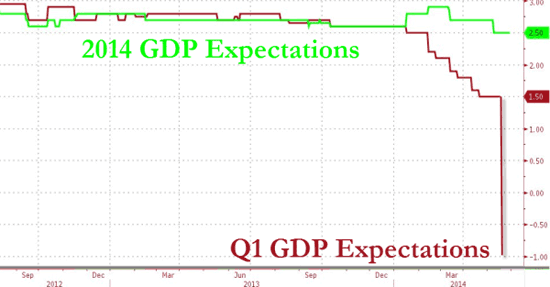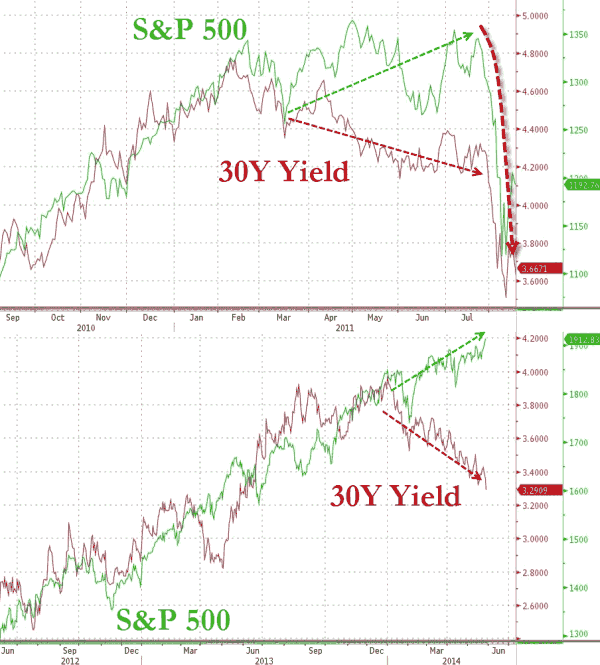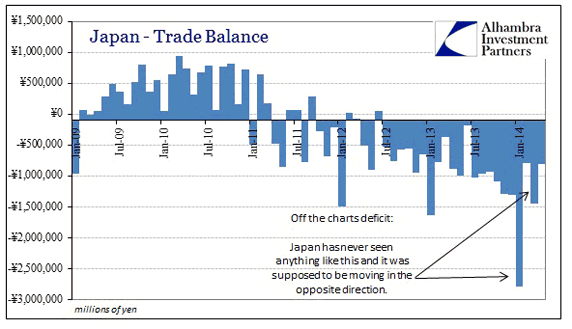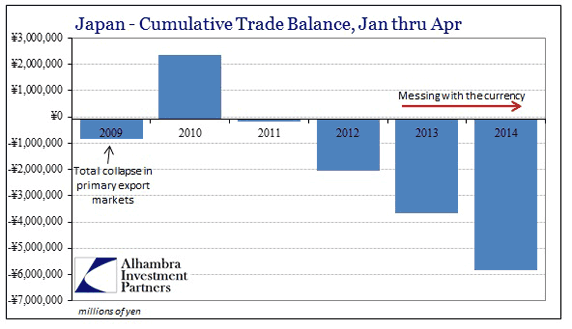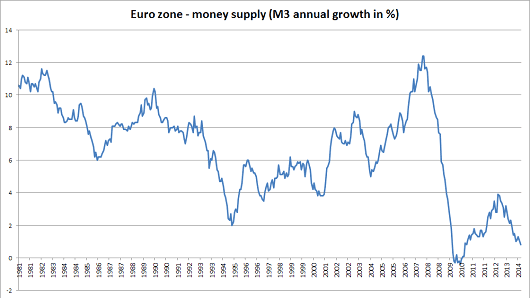
Jack Delano Military sentry at bridge over Colorado River, Topock, Arizona March 1943
With consensus building, after new health care data were released, that Q1 US GDP contracted by -2%, which is even worse than the latest -1% estimate, you’d think a bit of realism would pervade news reports. Think again. The ‘make it up as you go along’ factor only increases as numbers get worse. And, naive as I am, I can’t help wondering what the reason is for a journalist, whose MO should, at least in my view, contain a healthy dose of objectivity, to insist on making things look better and richer and growing more and faster than they really are. This attitude, which leans far too close for my comfort to viewing the world from a religious myopia, is practically all pervasive. And I strongly suggest that people keep that in the back of their heads no matter what they read. I personally – obviously – read lots of mainstream articles, and post links to quite a few, and I feel fine doing it because I have my BS radar on all the time. And I read and write lots of non-mainstream things to counter balance them. Hopefully, you do too. Here’s that latest contraction estimate (and again, I do adapt headlines at times to get to the essence of things):
US Q1 GDP Revised Downward To A -2% Contraction (WSJ)
The U.S. economy may have contracted more than previously thought during the first three months of 2014, private economists said Wednesday based on new health care-sector data from the government. Some analysts said economic output may have contracted at a 2% pace in the first quarter. That would be its worst performance since the recession. The Commerce Department’s latest estimate of GDP, the broadest measure of output across the economy, said it shrank at a seasonally adjusted annual rate of 1% in the first quarter. A revised estimate will be released June 25, and it could show an even larger contraction. That’s based on the Commerce Department’s Quarterly Estimates for Selected Service Industries report for the first quarter, released Wednesday. It showed that revenue in the U.S. health-care and social-assistance sector fell 2% in the first quarter from the fourth quarter of 2013, not adjusted for seasonal variations or price changes.
That’s pretty bad regardless of any other issues. If US GDP shrinks by -2% six-odd years into an alleged recovery, that is, to be frank, pretty frightening. That’s not how recoveries work or are supposed to work. Period. And while the mainstream press refuses to let go of the Q1 snow and ice story, and the non mainstream keeps on blowing holes in it, we did leave Q1 ten full weeks ago and things are not showing pent up demand or great surges in spending or recovery or anything like that. I mean, you can always hand pick a bunch of data and ignore the rest, but that just won’t do. Look, May is not Q1, it’s well into Q2:
Wholesale Prices in U.S. Unexpectedly Decreased in May
Wholesale prices in the U.S. unexpectedly fell in May, suggesting demand isn’t robust enough to push inflation closer to the Federal Reserve’s target. The 0.2% decrease in the producer price index compared with the median estimate in a Bloomberg survey of 71 economists that called for a 0.1% gain. Over the past 12 months, costs climbed 2%, figures from the Labor Department showed today. The May dip, the first in three months, suggests pricing power hasn’t yet materialized as the global economy is slow to accelerate. Muted costs are a problem for Federal Reserve policy makers, who have said they want inflation to increase closer to their 2% goal, a sign they will keep interest rate low well into 2015. “Producer price inflation is still fairly contained despite the big increases in the last few months,” Omair Sharif at RBS Securities said in a research note.
The most ‘out there’, and funniest at the same time, example today has got to be this Bloomberg piece, which was originally titled ‘May Sales Rise Less Than Forecast As Americans Take Respite’, and later changed into:
Cooling Sales Curb Optimism on U.S. Growth Rebound
American consumers paused for breath in May as retail sales climbed less than forecast following an impressive three-month run, tempering forecasts for a rebound in growth this quarter.
Americans took a breath, or a respite? From what, staying home in the cold? Or is it huge spending in April? Perhaps not.
This is from a May 13 Reuters article on April retail sales, Retail Sales Slow, But Growth Outlook Still Upbeat
… growth is expected to top a 3% rate this quarter. [..] While a gauge of consumer spending slipped in April, economists said the weak growth performance at the start of the year had probably made households more careful about spending. “It’s possible that consumers are being a bit more cautious in their spending habits as they await confirmation that the economy is, in fact, poised to reaccelerate,” said Jim Baird, CIO at Plante Moran Financial Advisors.
Wait, wait, hold on. Consumer spending slipped in April after a -2% Q1 number, and that’s because they were no longer cold, but … eh, but what? They were afraid it would get cold again? Or could it perhaps be that they spent all their money trying to stay warm? Just saying …
So-called core sales, which strip out automobiles, gasoline, building materials and food services and correspond most closely with the consumer spending component of GDP, dipped 0.1% in April. That followed a 1.3% advance in March. Still, economists were largely unframed by the drop and said consumer spending was on track to post a third consecutive quarter of robust growth, citing a firming labor market. “Despite an overall seemingly weak April retail sales report, thanks to the pop in March, the second quarter is starting off at a higher level that is consistent with strong consumption in the quarter,” said Bricklin Dwyer, economist at BNP Paribas.
A -2% Q1 GDP, but a “pop in March”, and ‘consumer spending slipped in April’. Now I’m getting confused. Anyway, April was weak, May was weak, but we still think Q2 GDP will ‘top a 3% rate’? That means June need to give us what, a 6%,7% gain? Really?
And moving back to the Bloomberg piece, excuse me, an impressive three-month run? What happened to the snow then? You see, three months ago we were still mired in Q1, and GDP fell -2% in that quarter. Did I miss something?
“It’s a story of gradual improvement,” said Michelle Girard, chief U.S. economist at RBS Securities [..] “We’re not getting the big acceleration that many people hoped for.”
That’s what I thought. No pent-up demand in sight. But that does make me wonder why someone would call it ‘gradual improvement’.
Consumers’ spirits are rising as job prospects strengthen. [..] “The most important of all economic indicators is employment, and since the jobs picture has improved, consumer attitudes are more upbeat,” said Richard Yamarone, a senior economist at Bloomberg. “If sustained, this could result in greater spending and overall economic growth.”
How is this not merely wishful thinking? If retail sales are cooling one month after GDP, 70% of which is consumers, was down -2%, where and how are ‘consumer spirits rising’?
Let’s try this angle: there was a cold winter, we all agree, but why don’t we subtract the increase in heating costs from the GDP number on the premise that it’s not an actual boost to the economy, since for many people it involved money they couldn’t spend twice, i.e. it directly interfered with the promise of any pent-up spending behavior. What would GDP look like then? How about -3%? I think we can all at least figure out the direction it would go in, even if not the exact percentage or amount. And yeah, unemployment at 6.3% is less bad than it was, but between ‘out of the labor force’ data and WalMart greeter and burger flipper “jobs”, don’t we all of us by now have a hunch of what jobless numbers are really like stateside? Why must we insist to persist in fooling one another about them? It only leads to a bewildering sequence of awfully wrong forecasts.
Governments, analysts, experts, pundits and journalists. A huge conspiracy built up to fool the American people. The Automatic Earth would do much better, attendance-wise and financially, if we were to simply follow that trend. Just keep on telling people the next quarter will be better, much better, and only have to swallow that sort of thing back half a year later, when no-one cares anymore and everyone’s fixated on newer data again. The media can say they only quoted government and experts, who in turn can claim their models really showed that dramatic uptick. But then every single one of you would be walking around in the emperor’s new clothes, perhaps feeling better short term, but exposed to ridicule, the elements and the debt you’ve gathered.
Let’s get this clear: the US economy is not doing well, at all, and it’s not picking up in any significant sense either, despite all the forecasts that always need to be revised downward at some later date (that’s not a coincidence, it’s an MO). Nor are other economies. China, Japan, EU, they’re all gasping for breath, not taking a breath. They’re also all issuing forecasts that are as rosy as they are absolute nonsense. But, you know, if everybody does it, that’s a safe place to be in, for who’s going to blame you?
I think Americans should be taking a breath alright, just not from spending money they don’t have to begin with or getting even deeper into debt, they should take a breath from “reports” intended to make them look like dumb-ass patsies.









• US Q1 GDP Revised Downward To A -2% Contraction (WSJ)
The U.S. economy may have contracted more than previously thought during the first three months of 2014, private economists said Wednesday based on new health care-sector data from the government. Some analysts said economic output may have contracted at a 2% pace in the first quarter. That would be its worst performance since the recession. The Commerce Department’s latest estimate of gross domestic product, the broadest measure of output across the economy, said GDP shrank at a seasonally adjusted annual rate of 1% in the first quarter. A revised estimate will be released June 25, and it could show an even larger contraction. That’s based on the Commerce Department’s Quarterly Estimates for Selected Service Industries report for the first quarter, released Wednesday.
It showed that revenue in the U.S. health-care and social-assistance sector fell 2% in the first quarter from the fourth quarter of 2013, not adjusted for seasonal variations or price changes. Hospital revenue fell a seasonally adjusted 1.3% from the prior quarter. The Commerce Department’s last GDP report, though, said inflation-adjusted spending on health-care services surged to a seasonally adjusted annual level of $1.848 trillion in the first quarter from $1.808 trillion in the fourth quarter of 2013. That estimate for spending on health care boosted overall GDP growth by 1.01%age point, keeping the 1% contraction from being even worse.
J.P. Morgan Chase economist Daniel Silver and Pierpont Securities economist Stephen Stanley both cautioned that it’s not clear exactly how the Commerce Department will adjust GDP to account for the new health-care services data. But they and other analysts downgraded their estimates for the first quarter based on the new survey, as well as other recently released data. Mr. Silver predicted GDP declined at a 1.6% pace in the first three months of the year. Mr. Stanley predicted contraction at a 2% pace. Macroeconomic Advisers also estimated GDP shrank at a 2% pace. “Ouch,” Mr. Stanley said in a note to clients.

• Cooling Sales Curb Optimism on US Economy (Bloomberg)
American consumers paused for breath in May as retail sales climbed less than forecast following an impressive three-month run, tempering forecasts for a rebound in growth this quarter. The 0.3% increase in purchases last month fell short of the median estimate of economists surveyed by Bloomberg that projected a 0.6% advance, Commerce Department figures showed today. Receipts for April were revised up to cap the strongest three months in almost two years. The slowdown in demand last month prompted some economists to shave forecasts for second-quarter gross domestic product just as reports this week signaled the economy slumped at the start of the year even more than previously estimated.
Other data today showing consumer confidence is firming and the job market is healing brighten the outlook for the rest of 2014. “It’s a story of gradual improvement,” said Michelle Girard, chief U.S. economist at RBS Securities Inc. in Stamford, Connecticut, and the second-best forecaster of retail sales over the past two years, according to Bloomberg data. “We’re not getting the big acceleration that many people hoped for.”

Central banks cannot win, they can only try to temporarily give the impression they can. Don’t be fooled.
• Carry Trade Nirvana Stymies Central Banks (Bloomberg)
Policy makers in Australia, New Zealand and Japan face the threat that the $5.3 trillion a day global foreign exchange market will derail their efforts to deliver sustainable economic growth. Central bank chiefs Glenn Stevens, Graeme Wheeler and Haruhiko Kuroda are struggling to rein in surging demand for their nations’ assets as their currencies climbed this week with investors focused on falling volatility and Japanese stocks. The kiwi and Aussie led gains among 31 major peers since June 6 while the yen is poised for its strongest week since early April. One-month implied volatility for Australia’s dollar slid its lowest level since 1996 yesterday, prompting traders to ignore this year’s 32% drop in prices for iron ore, the nation’s biggest export.
“As volatility moves lower, it’s really hard to fight the attraction of the Aussie and kiwi as carry trade currencies,” said Ray Attrill, the global co-head of currency strategy at National Australia Bank Ltd. in Sydney. “With the RBA clearly going no where for a long time to come, whenever volatility falls the carry attraction of the Aussie increases, which seems to be overriding every other factor at the moment.” In carry trades, investors buy high-yielding assets using money from nations with lower interest rates. A drop in the funding currency or a rise in the target exchange rate adds to the return from the interest-rate differential. Lower volatility lessens the chances the trade gets upended by sharp swings in exchange rates.

They’ve painted themselves into a corner they can only get out of by inflicting damage.
• Carney Sees Housing Debt Risk as Rate Increases Near (Bloomberg)
Mark Carney said rising U.K. mortgage debt may threaten Britain’s recovery as he signaled interest rates might start to rise earlier than anticipated. While investors don’t see the Bank of England’s benchmark rate increasing until next April, the central bank governor said it “could happen sooner than markets currently expect.” Speaking yesterday at the annual Mansion House speech in the City of London, he said higher borrowing costs could stretch over-leveraged households and undermine financial stability. The pound rose after the comments, which followed a pledge from Chancellor of the Exchequer George Osborne that the BOE’s Financial Policy Committee will get new powers to curb mortgage lending as a surging housing market raises concern about a potential bubble. Using those measures to head off a potential crisis could allow Carney to keep interest rates at a record-low for longer.
Employing such macroprudential tools “might also give Mr. Carney a bit of breathing space,” Neil MacKinnon, an economist at VTB Capital in London and a former U.K. Treasury official, said in a note. “However, market economists will be bringing forward the timing of the first U.K. rate hike into the end of this year.” MacKinnon said he will stick with his own forecast for an interest-rate increase in October. Before the speech, more than half the 29 financial institutions surveyed by Bloomberg predicted an increase in central bank rates by March, while forward contracts based on the sterling overnight interbank average, or Sonia, showed investors were betting the benchmark rate would rise 25 basis points by May.

• Carney Gets New Powers To Curb Mortgages To Prevent Asset Bubble (Guardian)
George Osborne is to give the Bank of England sweeping new powers to control the size of mortgages, as the Bank governor warns that interest rates are likely to rise before Christmas. Amid fears that rapidly rising house prices risk becoming a bubble that would threaten Britain’s economic recovery, the mortgage control measures will give Threadneedle Street the ability to impose direct curbs on the property market for the first time since the deregulation of the 1980s abolished queues for home loans. The moves by the Treasury to limit the amount of money people can borrow are an attempt to avoid damaging the entire economy with an increase in interest rates – something the governor of the Bank, Mark Carney, warned on Thursday could happen before the end of the year.
Carney said: “There’s already great speculation about the exact timing of the first rate hike and this decision is becoming more balanced. It could happen sooner than markets currently expect.” The City expects the first increase in official borrowing costs since 2007 to take place early next year. The new powers, which Osborne intends to push through parliament before next year’s election, were rejected as too draconian two years ago when the Treasury was deciding on the weapons needed by the Bank to prevent surges in asset prices causing financial crises. But the rapid recovery in the property market – especially in London, where price increases have averaged 18% over the last year – has forced a rethink, with Osborne convinced that the Bank should have a full range of alternatives to higher interest rates as a way of cooling down the housing market.

Unintended consequences?!
• UK Housebuilders Collapse On Rate Rise Fears (Telegraph)
Investors took fright and dumped shares in housebuilders after Mark Carney, the Governor of the Bank of England, signalled an earlier than expected interest rate rise, and Chancellor George Osborne gave the central bank new powers to curb mortgage lending in an effort to stave off a housing bubble. Persimmon dropped 4.8pc and Barratt Developments slid 4pc – the two heaviest fallers in the FTSE 100. In the mid-cap FTSE 250, Taylor Wimpey tumbled 4.7pc, Berkeley Group shed 4.2pc and Bovis Homes lost 4.1pc. Fears about the impact of a rate rise extended beyond the housebuilder stocks. Travis Perkins, the builders’ merchant also fell 2.6pc, while B&Q-owner Kingfisher cheapened 2.7pc. Howden Joinery, the kitchen supplier, was another casualty and declined 4.1pc.
Real estate investment trusts also fell, with British Land down 3.4pc and Land Securities off 3.2pc. The declines weighed on the wider market, with the FTSE 100 sliding 0.5pc to 6,809 and the FTSE 250 plunging 1.9pc to 15,826. Rebecca O’Keeffe, head of investment at broker Interactive Investor, said: “After months of managing market expectations on interest rates, we’ve seen the first hawkish signs from Mark Carney. “The remarks from the Governor have widened his immediate options as he starts to prepare the market for a return to higher rates. “With house price rises now a serious political issue and an increasing threat to financial stability, the Governor’s comments are the first warning to households that the landscape may be changing and that interest rates may rise sooner than expected.”

Dropping fast. Gravity at work.
• China May Home Sales Decline 11%, New Property Construction Down 19% (BW)
China’s home sales fell 11% in May from a year earlier amid slowing demand even after the central bank ordered easing of mortgage lending. The value of homes sold declined to 446.1 billion yuan ($72 billion) from 503 billion yuan in the same month in 2013, according to the difference between National Statistics Bureau data for the first half of the year and the first five months. The value of sales from January to May fell 10.2% to 1.97 trillion yuan from a year earlier, the data showed. China’s housing market, which faces a surplus of empty units as prices fall, has become a drag on the growth of the world’s second-largest economy. The central bank last month called on the nation’s biggest lenders to accelerate the granting of mortgages, urging them to give priority to first-home buyers.
“The property market is still not improving,” said Jinsong Du, a Hong Kong-based property analyst at Credit Suisse Group AG. “Developers may cut prices further, but the question is whether that will attract buyers.” Home prices fell for the first time on a monthly basis in May since June 2012, according to SouFun Holdings Ltd., China’s biggest real estate website owner. New property construction fell 19% to 599.1 million square meters (6.4 billion square feet) in the first five months of 2014 from a year earlier, today’s data showed.

Down down down. The danger here is that they borrowed huge amounts of money to grow, and there is no growth, but the loans still need to be paid back.
• China Real Estate Developers Face More Price Cuts In Q3 (Reuters)
Chinese property developers may be forced to embrace steeper price cuts, broader promotions or a change in strategy in the third quarter as they scramble to meet 2014 sales targets after many achieved less than 30% of their forecasts in the first five months. Price cuts would help boost sales and lower inventories, easing an oversupply of housing in the world’s second-largest economy. The cuts could however, come at the cost of profitability for many developers. Some developers are opting to adjust their strategies by introducing more basic housing where demand is solid compared to luxury apartments and by turning to commercial projects. “We are seeing more developers changing to renting their properties from selling because the market is very slow. By renting they can at least get some revenue,” said Raymond Wei, the Shanghai-based general manager for the commercial sector for realtor Centaline Property Agency Ltd.
Rating agency Standard and Poor’s said this week it expects China’s property sales to pick up from June, boosted by price cuts, and forecast full-year sales volume to rise 10%. Thomas Frank, the head of valuation in China for property consultancy Knight Frank, said a 20% cut in prices in second and third-tier cities would be more healthy for sales. China’s revenues from property sales dropped 8.5% in the first five months from a year earlier, the National Bureau of Statistics said on Friday, while growth in average new home prices in China slowed to a near one-year low in April, official data showed in May.
After seeing record sales of 8.14 trillion yuan ($1.31 trillion) in 2013, developers lifted their targets for this year by as much as 60%, despite a forecast slowdown in the real estate market as liquidity tightened and Beijing continued to cool the overheated sector. In the first five months, at least 13 Hong Kong-listed Chinese developers said they recorded a drop in sales compared to a year earlier, with declines ranging from single digits to more than 50%. China Resources Land said its sales fell 32%, resulting in it meeting just 28% of its full-year target.

Wrong lessons learned.
• China No-Money-Down Housing Echoes U.S. Subprime Loan Risks (Bloomberg)
China’s home buyers are being offered no-money-down purchases in an echo of the subprime lending that triggered a U.S. economic meltdown and the global financial crisis. Deals skirting government requirements for minimum 30% down payments have emerged this year from Guangzhou and Shenzhen in the south to Beijing in the north as real-estate sales slump, according to state media and statements by government agencies and developers. Loosening down-payment requirements could erode China’s financial stability by adding to risks for property companies, lenders and an economy already heading for the weakest growth in 24 years. Government warnings to consumers indicate that officials will strive to limit such arrangements, a sign of stress in a property market with a glut of homes. “The risk is severe for developers and third parties because there is no commitment from home buyers,” said Ding Shuang, senior China economist at Citigroup Inc in Hong Kong.
“Zero down payment has appeared in the U.S. before. It basically enabled unqualified people to buy houses,” said Ding, who used to work for the International Monetary Fund. “We need to see whether this will become widespread,” Ding said. “For now, it seems still sporadic.” The practice threatens to add to the build-up of risks in China’s $7 trillion shadow banking industry, with developers or third parties arranging funding to cover down-payment requirements, according to Shen Jianguang, Hong Kong-based chief Asia economist at Mizuho Securities Asia Ltd. In Guangzhou, in the southern province of Guangdong, nearly 20 housing developments rolled out no-down-payment plans to boost sales, Nanfang Daily, Guangdong’s official Communist Party newspaper, reported in April, as government agencies in Guangzhou and Shenzhen issued warnings against the practice. [..]
A 22% drop in the construction of new buildings in the first four months of 2014 highlighted the potential for property to drag down an economy projected to grow 7.3% this year, the slowest pace since 1990. UBS AG has estimated real-estate accounts for more than 25% of demand in the economy, including spin-offs from construction machinery to household appliances. “The oversupply problem is very severe,” Gan Li, director of the Survey and Research Center for China Household Finance, said in Beijing on June 10, citing a survey of 28,000 households in 29 provinces that indicated 22% of urban homes were vacant in 2013.

Pushing on a string.
• China’s New Loans, Money Supply Top Estimates (Bloomberg)
China’s new yuan loans and money supply topped estimates in May as the government supports economic growth while reining in shadow banking. Local-currency loans were 870.8 billion yuan ($140 billion), the People’s Bank of China said on its website yesterday. M2, the broadest measure of money supply, rose 13.4%, compared with a median projection for 13.1%. China is in danger of missing a 2014 target for economic growth of about 7.5%, prompting Premier Li Keqiang to speed up government spending and make limited cuts to lenders’ reserve requirements. The World Bank warned last week that rapid credit growth and debt accumulation by local governments are risks to financial stability.
“May is the first month this year we’ve seen a sizable easing of liquidity as evidenced by the strong new bank loans,” said Larry Hu, head of China economics at Macquarie Securities Ltd. in Hong Kong. “It suggests that policy makers are turning more serious about the downside risks to the economy and began ramping up pro-growth measures.” The PBOC’s report was released after the close of China’s stock markets. The benchmark Shanghai Composite Index fell for the first time this week on concern economic data to be released later today for May industrial output and retail sales, and January-May fixed-asset investment, will be weaker than analysts estimate.

Portrait of a collapsing market.
• China’s First-Home Buyers Shrink as Market Slows (Bloomberg)
The ranks of China’s first-home buyers have shrunk amid a market slowdown, according to a report from the Survey and Research Center for China Household Finance. About 20% of buyers are purchasing homes for the first time this year, according to a survey between August and March, compared with 48% in 2012, said Gan Li, director of the center and a professor at Southwestern University of Finance Economics. Such buyers accounted for 90% in 2000, said Gan, who surveyed 28,000 households in 29 Chinese provinces. “The era of Chinese real estate industry being driven by first-time homebuyer demand is over,” Gan said after a press conference in Beijing today. “The market is going to be driven by investment and improvement in demand that is sensitive to price.”
Chinese government’s four-year efforts to rein in property prices have been aimed at squeezing speculative investments out of the market by increasing second-home mortgages and imposing home-purchase restrictions. Home prices fell for the first-time in May on a monthly base since June 2012, according to SouFun Holdings Ltd., the country’s biggest real estate website. More than 55% of households purchasing new homes this year already own one place, compared with 43% in 2013, according to the report. 21% of Chinese urban households own more than one home, it said.

‘Sticks With Easing’ doesn’t begin to tell the story. Abe is wagering it all. But the problem in Japan is not the money supply – which he’s fast increasing – , it’s consumer spending. And the only way to increase that is by trying to hurt people’s savings even more than he already has. However, that does not make people spend, it just makes them even more scared, and less prone to spending.
• BOJ Sticks With Easing as Analysts Delay Action Calls (Bloomberg)
The Bank of Japan raised its view of overseas economies while maintaining unprecedented stimulus as Governor Haruhiko Kuroda strives to boost inflation that remains short of a 2% target. The central bank will continue to expand the monetary base at a pace of 60 trillion yen to 70 trillion yen ($688 billion) per year, it said in a statement today in Tokyo, in line with estimates of all 33 economists in a Bloomberg News survey. A rebound in consumer sentiment and signs of strength in business investment indicate some resilience in the world’s third-biggest economy after April’s sales-tax increase. At the same time, a rebound in the yen after last year’s 18% decline against the dollar threatens to undercut inflation, with most economists surveyed by Bloomberg forecasting the central bank will boost stimulus this year to achieve its goal.
“The BOJ is growing more confident about the economy and its outlook,” said Naoki Iizuka, an economist at Citigroup Inc. in Tokyo. “Still, weakness in consumer spending and a halt in yen declines make it doubtful inflation will accelerate, prompting the BOJ to add to easing in October.” Consumer prices excluding fresh food rose 3.2% in April, the fastest pace since 1991. Stripping the impact of the 3%age point increase in the sales tax, core prices — the BOJ’s preferred inflation gauge — climbed 1.5%, according to a BOJ estimate.

What is the benefit to society of this? And why then do we tolerate it?
• Dark Pools, Off-Exchange Trading Of US Stocks On The Rise (Bloomberg)
The rise of off-exchange trading in the U.S. stock market continues unabated even as regulators question the wisdom of allowing the shift to continue. Shares changing hands in private venues such as dark pools accounted for 40.4% of total share volume on June 10, according to data compiled by Bloomberg. That’s the most since 41.7% took place off-exchange on June 22, 2012. The three biggest exchange companies each matched about 20% of trading on June 10. The high came after Securities and Exchange Chair Mary Jo White last week voiced concerns about the level of trading taking place on venues where bids and offers are kept private, masking the true depth of demand for shares. The rise in off-exchange trading came as calmness pervaded markets, with the Chicago Board Options Exchange Volatility Index, also known as the VIX, sliding to a seven-year low last week.
“Its been clearly demonstrated that the less volatile markets are, the more people trade away from exchanges,” Justin Schack, partner and managing director for market structure analysis at Rosenblatt Securities Inc., said in a phone interview. “Brokers also have an incentive to avoid exchanges and their fees, and with overall volumes low, the pressure to avoid costs is quite high.” The total number of shares traded on June 10 was 5.19 billion, according to data compiled by Bloomberg, compared with this year’s daily average of about 6.5 billion. Alternative trading systems, broker-run private venues which include dark pools, have been under increasing scrutiny in recent months. The New York attorney general has requested information from them in a probe related to high-frequency trading, a person familiar with the matter said last month. In May, ATSs began reporting more data on their trading to the Financial Industry Regulatory Authority, which posted the information on its website.

How many zeroes can you take before getting dizzy?
• 12 Numbers From The Global Financial Ponzi Scheme (M. Snyder)
The truth is that our financial system is little more than a giant pyramid scheme that is based on debt and paper promises. It is literally a miracle that it has survived for so long without collapsing already. When Americans think about the financial crisis that we are facing, the largest number that they usually can think of is the size of the U.S. national debt. And at over $17 trillion, it truly is massive. But it is actually the 2nd-smallest number on the list below. The following are 12 numbers about the global financial Ponzi scheme that should be burned into your brain…
• $1,280,000,000,000 – Most people are really surprised when they hear this number. Right now, there is only $1.28 trillion worth of U.S. currency floating around out there.
• $17,555,165,805,212.27 – This is the size of the U.S. national debt. It has grown by more than $10 trillion over the past ten years.
• $32,000,000,000,000 – This is the total amount of money that the global elite have stashed in offshore banks (that we know about).
• $48,611,684,000,000 – This is the total exposure that Goldman Sachs has to derivatives contracts.
• $59,398,590,000,000 – This is the total amount of debt (government, corporate, consumer, etc.) in the U.S. financial system. 40 years ago, this number was just a little bit above $2 trillion.
• $70,088,625,000,000 – This is the total exposure that JPMorgan Chase has to derivatives contracts.
• $71,830,000,000,000 – This is the approximate size of the GDP of the entire world.
• $75,000,000,000,000 – This is approximately the total exposure that German banking giant Deutsche Bank has to derivatives contracts.
• $100,000,000,000,000 – This is the total amount of government debt in the entire world. This amount has grown by $30 trillion just since mid-2007.
• $223,300,000,000,000 – This is the approximate size of the total amount of debt in the entire world.
• $236,637,271,000,000 – According to the U.S. government, this is the total exposure that the top 25 banks in the United States have to derivatives contracts. But those banks only have total assets of about $9.4 trillion combined. In other words, the exposure of our largest banks to derivatives outweighs their total assets by a ratio of about 25 to 1.
• $710,000,000,000,000 to $1,500,000,000,000,000 – The estimates of the total notional value of all global derivatives contracts generally fall within this range. At the high end of the range, the ratio of derivatives exposure to global GDP is about 21 to 1.

Must read from George. Get to know yourself.
• Shifting Baseline Syndrome And The Values Ratchet (Monbiot)
Any political movement that fails to understand two basic psychological traits will, before long, fizzle out. The first is Shifting Baseline Syndrome. Coined by the biologist Daniel Pauly, it originally described our relationship to ecosystems, but it’s just as relevant to politics. We perceive the circumstances of our youth as normal and unexceptional – however sparse or cruel they may be. By this means, over the generations, we adjust to almost any degree of deprivation or oppression, imagining it to be natural and immutable.
The second is the Values Ratchet (also known as policy feedback). If, for example, your country has a public health system which ensures that everyone who needs treatment receives it without payment, it helps instil the belief that it is normal to care for strangers, and abnormal and wrong to neglect them. If you live in a country where people are left to die, this embeds the idea that you have no responsibility towards the poor and weak. The existence of these traits is supported by a vast body of experimental and observational research, of which Labour and the US Democrats appear determined to know nothing.
We are not born with our core values: they are strongly shaped by our social environment. These values can be placed on a spectrum between extrinsic and intrinsic. People towards the intrinsic end have high levels of self-acceptance, strong bonds of intimacy and a powerful desire to help other people. People at the other end are drawn to external signifiers, such as fame, financial success, image and attractiveness. They seek praise and rewards from others. Research across 70 countries suggests that intrinsic values are strongly associated with an understanding of others, tolerance, appreciation, cooperation and empathy. Those with strong extrinsic values tend to have lower empathy, a stronger attraction towards power, hierarchy and inequality, greater prejudice towards outsiders and less concern for global justice and the natural world. These clusters exist in opposition to each other: as one set of values strengthens, the other weakens.
People at the extrinsic end tend to report higher levels of stress, anxiety, anger, envy, dissatisfaction and depression than those at the intrinsic end of the spectrum. Societies in which extrinsic goals are widely adopted are more unequal and uncooperative than those with deep intrinsic values. In one experiment, people with strong extrinsic values who were given a resource to share soon exhausted it (unlike a group with strong intrinsic values), as they all sought to take more than their due(15).

Spain and Britain can now do what they always wanted: let her rip! Monsanto wins another one.
• EU Deal Opens Floodgate to GMO Crops (RT)
European Union governments have decided to let member states go their own way when it comes to genetically modified organisms (GMOs), allowing EU nations to either ban the crops or grow them as they see fit. The move ends years of legislative deadlock. At a meeting in Luxembourg, EU environment ministers from 26 out of 28 member states put their weight behind a 2010 proposal to give national governments an opt out from rules, making the 28-member bloc a single market for GMOs. Only Belgium and Luxembourg voted against it, although the final decision rests with the European Parliament, which is expected to endorse the plan, Bloomberg Businessweek reports.
A political split in Europe between countries in favor of GMOs, such as Britain and Spain, and those firmly against them, including France, has delayed EU-wide permission to grow them. This has prompted complaints from trading partners – such as the US, where GMOs are legal – which are seeking to expand the global bio seed market, which is valued at almost US$16 billion a year. The law will accelerate EU level endorsements for requests from US companies like Monsanto to plant genetically altered crops, which have been cleared as safe by scientists working for the European Commission. “This is a real step forward in unblocking the dysfunctional EU process for approving GM crops, which is currently letting down our farmers and stopping scientific development,” said Owen Paterson, UK secretary of state for the environment.



